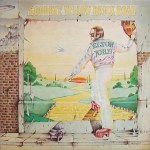More Reviews and Commentaries for Goodbye Yellow Brick Road
The richness, sweetness and freedom from artificiality is most obvious where you often hear it on a Pop Rock Big Production like GYBR: in the loudest, densest, most climactic choruses.
We set the playback volume so that the loudest parts of the record are as huge and powerful as they can possibly become without crossing the line into distortion or congestion.
On some records, Dark Side of the Moon comes instantly to mind, the guitar solos on Money are the loudest thing on the record.
On Breakfast in America the sax toward the end of The Logical Song is bigger and louder than anything on the record, louder even than Roger Hodgson’s near-hysterical multi-tracked screaming “Who I am” about three quarters of the way through the track. Those, however, are clearly exceptions to the rule. Most of the time it’s the final chorus of a pop song that gets bigger and louder than what has come before.
A pop song is usually designed to build momentum as it works its way through the verses and choruses, past the bridge, coming back around to make one final push, releasing all its energy in the final chorus, the climax of the song. On a good recording — one with real dynamics — that part of the song should be very loud and very powerful.
Testing the Climaxes
The climax of the biggest, most dynamic songs are almost always the toughest tests for a pop record, and it’s the main reason we play our records loud. The copies that hold up through the final choruses of their album’s largest scaled productions are the ones that provide the biggest thrills and the most emotionally powerful musical experiences one can have sitting in front of two speakers. Our Top 100 is full of records that reward that kind of intense listening at loud levels.
We live for that sound here at Better Records. It’s precisely what the best vintage analog pressings do so brilliantly. In fact they do it so much better than any other medium that there is really no comparison, and certainly no substitute. If you’re on this site you probably already know that.
Two to Listen For
Number one: Too many instruments and voices jammed into too little space in the upper midrange. When the tonality is shifted-up, even slightly, or there is too much compression, there will be too many elements — voices, guitars, drums — vying for space in the upper part of the midrange, causing congestion and a loss of clarity.
With the more solid sounding copies, the lower mids are full and rich. Above them, the next “level up” so to speak, there’s plenty of space in which to fit all the instruments and voices comfortably, without piling them on top of one another as so often happens. Consequently, the upper midrange “space” does not get overloaded and overwhelmed with musical information.
Number Two: edgy vocals, which is related to Number One above. Almost all copies have at least some edge to the vocals — the boys want to really belt it out in the choruses, and they do — but the best copies keep the edge under control, without sounding compressed, dark, dull or smeary.
The highest quality equipment, on the hottest Hot Stamper copies, will play the loudest and most difficult-to-reproduce passages with virtually no edge, grit or grain, even at very loud levels.
Elton John Shootouts
Elton John is one of the handful of artists to produce an immensely enjoyable and meaningful body of work throughout the ’70s, music that holds up to this day. The music on his albums, so multi-faceted and multi-layered, will endlessly reward the listener who makes the effort and takes the time to dive deep into the sound of his classic releases.
Repeated plays are the order of the day. The more critically you listen, the more you are sure to discover within the exceedingly dense mixes favored by Elton and his bandmates. And the better your stereo gets the more you can appreciate the care and effort that went into the production of the recordings.
Elton John albums always make for tough shootouts. His producers’ (Gus Dudgeon being the best of them) and engineers’ (Ken Scott and Robin Geoffrey Cable, likewise the best) approach to recording — everything-but-the-kitchen-sink as a rule — make it difficult to translate their complex sounds to disc, vinyl or otherwise.
Everything has to be tuned up and on the money before we can even hope to get the record sounding right. Careful VTA adjustment could not be more critical in this respect.
If we’re not hearing the sound we want, we keep messing with the adjustments until we do. There is no getting around sweating the details when sitting down to test a complex recording such as this. If you can’t stand the tweaking tedium, get out of the kitchen (or listening room, as the case may be). Obsessing over every aspect of record reproduction is what we do for a living.
When you love it, it’s not work — it’s fun. Tedious, occasionally exasperating fun, but still fun nonetheless.
A Must Own Rock Record
GYBR is a recording that belongs in any serious Rock Music Collection. Others in that category can be found here.
Further Reading
